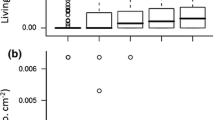Abstract
Resource competition and chemical interference are mechanisms of interaction among plants that may occur simultaneously. However, both mechanisms are rarely considered together when modelling plant growth. We propose a new empirical model that estimates biologically significant parameters on both plant competition and chemical interference. The model is tested with data sets from different density-dependent experiments done with two species (the grass Lolium rigidum Gaud. and the legume Glycine max soya L.) subjected to a noxious chemical environment when growing (allelochemicals and herbicides, respectively). Hypotheses on the effect of allelochemicals and its interaction with density are tested using maximum likelihood ratio tests in order to ask, for these species, whether chemical interference is playing a significant role in the interactions among plants or on the contrary, whether interactions among plants are sufficiently explained by the resource competition. In all cases a significant interaction between chemicals and density is observed. This interaction is inconsistent with the hypothesis of only resource competition having an influence of plant biomass and suggests a significant density-dependent effect of chemicals on plant growth.




Similar content being viewed by others
References
An M, Johnson IR, Lovett JV (1993) Mathematical modelling of allelopathy: biological response to allelochemicals and its interpretation. J Chem Ecol 19:2379–2388
Bertness MD, Shumway SW (1993) Competition and facilitation in marsh plants. Am Nat 124:718–724
Bloom AJ, Chapin FS, Mooney HA (1985) Resource limitation in plants—an economic analogy. Ann Rev Ecol Syst 16:363–392
Callaway RM, King L (1996) Temperature-driven variation in substrate oxygenation and the balance competition and facilitation. Ecology 77:1189–1195
Canals RM, San Emeterio L, Peralta J (2005) Autotoxicity in Lolium rigidum: analyzing the role of chemically mediated interactions in annual plant populations. J Theor Biol 235:402–407
Craine JM (2006) Competition for nutrients and optimal root allocation. Plant Soil 285:171–185
Damgaard C (1998) Plant competition experiments: testing hypotheses and estimating the probability of coexistence. Ecology 79:1760–1767
Damgaard C (2003) Modelling plant competition along an environmental gradient. Ecol Model 170:45–53
Damgaard C (2004) Dynamics in a discrete two-species competition model: coexistence and over-compensation. J Theor Biol 227:197–203
Damgaard C, Weiner J, Nagashima H (2002) Modelling individual growth and competition in plant populations: growth curves of Chenopodium album at two densities. J Ecol 90:666–671
Firbank LG, Watkinson AR (1985) On the analysis of competition within two-species mixtures of plants. J Appl Ecol 22:503–517
Hacker SD, Bertness MD (1995) Morphological and physiological consequences of a positive plant interaction. Ecology 76:2165–2175
Harper JL (1977) Population biology of plants. Academic press, London
Huckle JM, Marrs RH, Potter JA (2002) Interspecific and intraspecific interactions between salt marsh plants: integrating the effects of environmental factors and density on plant performance. Oikos 96:307–319
Inderjit KMM, del Moral R (1997) Is separating resource competition from allelopathy realistic? Bot Rev 63:221–230
Law R, Watkinson AR (1987) Response-surface analysis or two-species competition: an experiment on Phleum arenarium and Vulpia fasciculata. J Ecol 75:871–886
Liu DL, An M, Johnson IR, Lovett JV (2005) Mathematical modelling of allelopathy: I.V. assessment of contributions of competition and allelopathy to interference by barley. Nonlinearity Biol Toxicol Med 3:213–224
Maestre FT, Bautista S, Cortina J (2003) Positive, negative, and net effects in grass-shrub interactions in Mediterranean semiarid grasslands. Ecology 84:3186–3197
Mead R (1970) Plant density and crop yield. Appl Statist 19:64–81
Nilsson MC (1994) Separation of allelopathy and resource competition by the boreal dwarf shrub Empetrum hermaphroditum Hagerup. Oecologia 98:1–7
Reigosa MJ, Sanchez-Moreiras A, Gonzalez L (1999) Ecophysiological approach in allelopathy. Critical Rev Plant Sci 18:577–608
Ridenour WM, Callaway RM (2001) The relative importance of allelopathy in interference: the effects of an invasive weed on native bunchgrass. Oecologia 126:444–450
San Emeterio L, Arroyo A, Canals RM (2004) Allelopathic potential of Lolium rigidum Gaud. on the early growth of three associated pasture species. Grass Forage Sci 59:107–112
Seber GAF, Wild CJ (1989) Non linear regression. John Wiley, New York
Sinkkonen A (2001) Density-dependent chemical interference—an extension of the biological response model. J Chem Ecol 27:1513–1523
Sinkkonen A (2003) A model describing chemical interference caused by decomposing residues at different densities of growing plants. Plant Soil 250:315–322
Stoll P, Weiner J (2000) A neighbourhood view of interactions among individual plants. In: Dieckmann U, Law R, Metz JAJ (eds) The geometry of ecological interactions: simplifying spatial complexity. Cambridge University Press, pp 11–27
Thijs H, Shann JR, Weidenhamer JD (1994) The effect of phytotoxins on competitive outcome in a model system. Ecology 75:1959–1964
Weidenhamer JD (1996) Distinguishing resource competition and chemical interference: overcoming the methodological impasse. Agron J 88:866–875
Weidenhamer JD, Harnett DC, Romeo JT (1989) Density-dependent phytotoxicity: distinguishing resource competition and allelopathic interference in plants. J Appl Ecol 26:613–624
Acknowledgments
We thank Jacob Weiner, and other anonymous reviewers for valuable comments and Birgit Nielsen for helping on the writing process. Part of the research was done in the National Environmental Research Institute of Silkeborg, Denmark. The research was funded by the Navarra Council for Education and Culture (2002–2003), and the Public University of Navarra defrayed the costs of a first author’s stay in Denmark.
Author information
Authors and Affiliations
Corresponding author
Rights and permissions
About this article
Cite this article
San Emeterio, L., Damgaard, C. & Canals, R.M. Modelling the combined effect of chemical interference and resource competition on the individual growth of two herbaceous populations. Plant Soil 292, 95–103 (2007). https://doi.org/10.1007/s11104-007-9205-9
Received:
Accepted:
Published:
Issue Date:
DOI: https://doi.org/10.1007/s11104-007-9205-9




